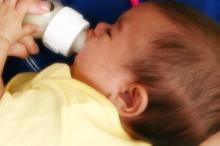Type of Infant Formula May Alter Later Risk of Type 1 Diabetes
Major Finding: The 113 neonates who received casein-based formula were significantly less likely to develop signs of beta-cell autoimmunity than were 117 neonates who received standard cow’s-milk–based formula, up to age 10. The intervention formula was associated with a significant decrease in risk of seropositivity for islet-cell antibodies, IA-2 autoantibodies, or to at least one of the five autoantibodies assessed.
Data Source: A multicenter Finnish pilot study involving 230 neonates randomly assigned to receive an intervention or a control formula for at least 6 months, then followed for up to 10 years.
Disclosures: This study was funded by the Academy of Finland, the European Commission, the Juvenile Diabetes Foundation, the Novo Nordisk Foundation, and several other nonindustry sources. Infant formulas were provided by Mead Johnson Nutrition, which had no role in the study design, collection or analysis of data, or preparation of the manuscript. Dr. Knip’s associate, Dr. Anu-Maaria H?m?l?ainen, reported receiving a grant from the Foundation for Paediatric Research. Dr. Knip and the other associates reported no conflicts of interest.
FROM THE NEW ENGLAND JOURNAL OF MEDICINE
Children at risk for type 1 diabetes showed fewer signs of beta-cell autoimmunity for up to 10 years if they were fed a highly hydrolyzed casein formula rather than conventional cow’s-milk–based formula during infancy, according to a report in the Nov. 11 issue of the New England Journal of Medicine.
This indicates that "a preventive dietary intervention aimed at decreasing the risk of type 1 diabetes may be feasible," said Dr. Mikael Knip of the University of Helsinki, Finland, and his associates.
Their pilot study – the Trial to Reduce IDDM in the Genetically at Risk (TRIGR) – was not sufficiently powered to render a definitive conclusion about preventing progression to overt type 1 diabetes. However, a larger ongoing TRIGR study is now underway in 15 countries and is designed to address that issue, the investigators noted.
The pilot study involved 230 neonates born at 15 Finnish hospitals between 1995 and 1997 whose HLA genotypes showed susceptibility to type 1 diabetes and who had at least one first-degree relative with the disorder. The newborns were randomly assigned in a double-blind fashion to receive for at least 6 months either an extensively hydrolyzed casein-based formula (Nutramigen) or a control cow’s-milk–based formula made to smell and taste like the intervention formula.
Both formulas were offered only when breast milk was unavailable. Breast-feeding was encouraged, and mothers breast-fed at their own discretion and without modifying their diets.
Blood samples were obtained periodically to test for five disease-related autoantibodies: islet-cell antibodies; insulin antibodies; and antibodies to glutamic acid decarboxylase (GAD), the tyrosine phosphatase-related insulinoma-associated 2 molecule (IA-2), and zinc transporter 8 (ZnT8).
The intervention formula was associated with a significant decrease in risk of seropositivity for islet-cell antibodies, IA-2 autoantibodies, or to at least one of the five autoantibodies assessed, Dr. Knip and his colleagues said (N. Engl. J. Med. 2010;363:1900-8).
By 10 years of age, 6% of children in the intervention group and 8% of those in the control group developed type 1 diabetes. This difference was nonsignificant, but the study was not designed to demonstrate significance of this measure, they added.
Although preliminary data from small clinical studies and animal studies have suggested that "complex foreign-protein diets during weaning may play a deleterious role in the process leading to autoimmune diabetes," the mechanism is not yet known. "We speculate that potential mechanisms may involve reduced gut permeability, induction of the maturation of regulatory T cells in the gut-associated lymphoid tissue, modification of the gut microflora, or some combination of these," the investigators said.
If further study confirms that highly hydrolyzed formula safely protects high-risk children from developing type 1 diabetes, "a next step might be to expand the intervention to a wider infant population, since 83%-98% of children with newly diagnosed type 1 diabetes are from the general population," Dr. Knip and his associates added.
This strategy could be a relatively easily implemented public health measure, they said.
This study was funded by the Academy of Finland, the European Commission, the Juvenile Diabetes Foundation International, the Novo Nordisk Foundation, and several other nonindustry sources. Infant formulas were provided by Mead Johnson Nutrition, which had no role in the study design, collection or analysis of data, or preparation of the manuscript. Dr. Knip’s associate reported receiving a grant from the Foundation for Paediatric Research. Dr. Knip and the other associates reported no conflicts of interest.





